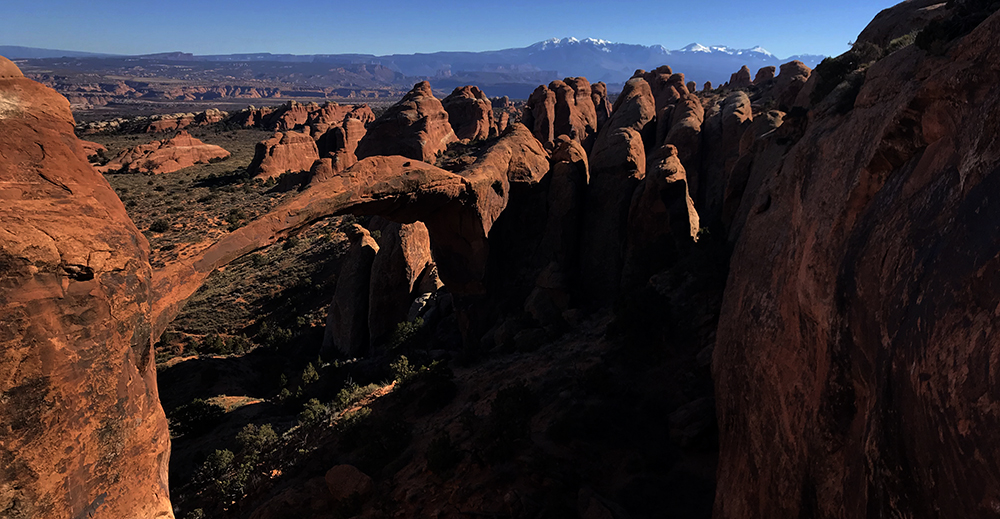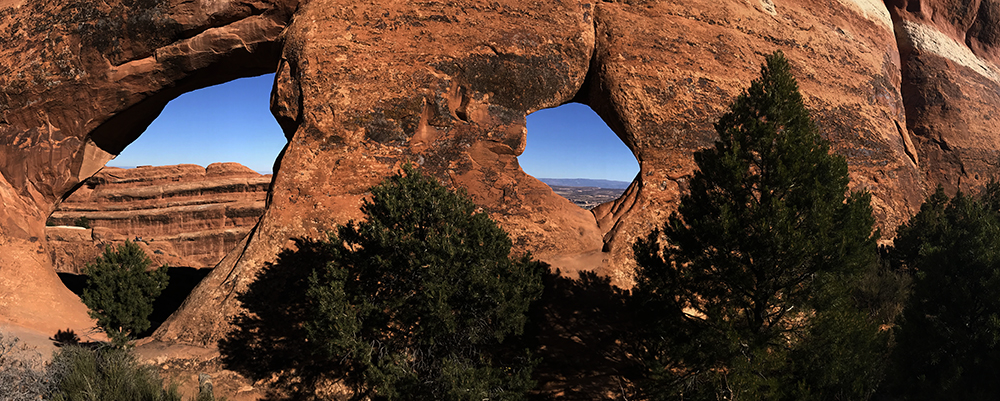With more than 2,000 natural rock arches found within a mere 76,000 acres, Utah’s Arches National Park is home to more of its bizarre namesake features than any other site in the world…
Guide to Arches
Alert
Arches National Park has implemented a limited entry program between April 1 and October 31. In order to get through the gates, you’ll need to go on over to Rec.gov and obtain a reservation.
NPS – Arches – Entrance Permit
Now, if you have a 4×4 with relatively high clearance, and you know how to drive it, you can skip the lines, and cruise about 5 miles or so north of Moab on Hwy 191 to Willow Springs Road. Take this road to the east and it eventually leads to Balanced Rock, right smack in the middle of Arches National Park.
NPS – Arches – Current Visitation Levels
Arches National Park
Just north of Moab, in eastern Utah, the curious desert traveler will come upon the gate to Arches National Park. A right-hand turn here will lead into a maze of sandstone arches, some of which span lengths in excess of 300 feet. Their thin spines seem to ignore gravity, and our desert traveler is forced to ponder how long they can exist in this forlorn state of geometric defiance.
A great number of these bizarre arches are visible along the park’s 40 mile scenic drive, and many others require only a short stroll from our desert traveler’s ol’ metal coffin.
Indeed, with such spectacular scenery so readily visible, most visitors never feel the need to leave the damned pavement. It’s just so gorgeous here that these poor fools don’t even realize that they missed anything. Somehow, despite the grandeur of this red rock kingdom, the average park visit lasts a mere two hours…
Meanwhile, those who enter the wilderness of Arches, discover a land that speaks to the soul and can reveal volumes of ancient wisdom. The opportunity for rugged exploration here is immense and the backcountry is home to wonders that you will not soon forget. Despite the crowded parking lots, the Arches backcountry feels refreshingly vacant. If you want to get away from it all in Arches, you certainly can.
Exploring Arches
The park has one visitor center, located at the gate of the park. Most visits begin here. Of course, you’ll want to see the park movie and get your passport stamp to show all of your homies that you’ve been to Arches, or maybe simply to remind yourself of the fact one fine day when you finally lose your mind… That’s why I get my stamps…

The majority of visitors to Arches bring a private vehicle into the park and use it to navigate the scenic drive. There is only one paved route through the park which runs 18 miles one-way from the visitor center to Devil’s Garden. This is home to the park’s only developed campground, as well as the Devil’s Garden Loop, which at just over 7 miles, is the park’s longest maintained trail.
The park’s main artery is busy during most of the year. During peek times, the NPS will close the scenic drive to inbound traffic, so it helps to enter the park early and to have a plan. Spring and summer crowds propel the number of daily visitors into the thousands and you’ll know it when you begin to seek a parking space.
For those with a Jeep or similar high clearance 4×4, there are other driving options which allow the visitor to experience a slice of backcountry solitude. The Klondike Bluffs are a fun hiking destination which require a short trip on a dirt road that seems to be well consistently well-maintained.
“If Delicate Arch has any significance, it lies… I’ll venture, in the power of the odd and unexpected to startle the senses and surprise the mind out of their ruts of habit, to compel us into a reawakened awareness of the wonderful – that which is full of wonder.”
Edward Abbey – 1968
For a more adventurous drive, a trip down an unmaintained back route on the park’s west boundary will provide access to a few out-of-the-way arches, such as Eye of the Whale Arch. This area will definitely require a high clearance 4×4, but visitors needn’t worry about crowds, or parking spaces.
See the Visiting Arches page for more information on camping and seeing the park.
What to do in Arches
The park offers numerous hiking options. These range from easy strolls to overlooks that lie just minutes from the comfort of your air conditioned seats, to extreme backcountry jaunts into unknown areas of mystery such as the infamous Fiery Furnace. This area of the park requires a permit and offers no maintained trail, which means you’ll want a bit of route-finding ability before you cruise out into this one. For those who feel such travel a bit risky, the park service offers ranger-led tours of this unique area.
There are opportunities for backcountry exploration and camping in the park as well, although the park is relatively small and such options are not as abundant as in many other western parks. Nevertheless, there is plenty of space, and it is unlikely you’ll send me any hate mail complaining of crowded conditions in the Arches backcountry.

Previously, there were no actual backcountry campsites and users could simply choose their own site on the land. However, as of June, 2018, the park is establishing a new backcountry management system, which indicates that there will now be designated backcountry sites and usage limits in place.
Rock climbing and canyoneering are possible in Arches, although heavily restricted. Equestrian folk will find the stock-stoke high as well, as they can find opportunities to get away from it all in a labyrinth of red rock features. I trust that passing horses and mules may very well appreciate the complex geological forces that acted upon this landscape far more than we may acknowledge.
For information about what to do in Arches and a descriptive list of hiking trails and canyoneering options, see the Arches Activities page.
Arches from Salt?
Yep, salt… well sort of…
You see, in ancient times, (300 million years ago) this area of the American West was subjected to the repeated advance and subsequent evaporation of numerous inland seas. Upon evaporation, the seas left their salt behind, and over time, they left a very large amount of it. In places, retreating seas deposited beds of salt that was more than two miles thick!
Eventually, sand and miscellaneous materials formed layers of sandstone atop the salt, which subsequently shifted under the massive weight of the stone above. Over time, this forced the sandstone to collapse on itself in weaker areas, which left cracks and cavities that, once open to the elements of erosion, began to form fins that often contained weak centers which eroded prior to the surrounding layers, leaving behind the arches that we see today.

Three hundred million years in the making, Arches National Park beautifully showcases the harsh, yet exquisite effects of time, weather and physics upon a section of raw desert sandstone that was deposited atop a thick layer of salt.
While this landscape may appear quite durable, it is indeed, very fragile and today’s visitors are reminded of this by the continual reshaping of these features by natural forces. In 1991, a large section of the famed Landscape Arch collapsed leaving a sliver of rock behind as evidence of the fact that slowly, these delicate formations all come down.
Gravity will win my friends… Gravity will win…
That said, visitors should be aware that it is against park legal policies to climb or walk on any arches that lie within the boundary of Arches National Park. Stay off the damn arches…
Park Junkie Verdict
It is likely that there is something here for just about everyone, and it is further likely that you’ll be posting to your IG account immediately upon your retreat from the fascinating structures here in Arches…
I always take the opportunity to spend a bit of time in Arches. It is a small park, but there is plenty of room to get away from it all if you don’t mind taking the road less traveled by. The park’s few trails can seem somewhat crowded at times, and the park gates near Moab can present a bothersome wait to enter the park, or an entrance denial during times of increasing congestion.
However, there are endless scenes of beauty within the park, so a short wait can seem insignificant by the day’s end. Those with motorcycles or 4x4s needn’t wait at the gates, as a couple of backcountry entrances allow quick passage into the park’s western regions, but these areas are remote and rugged, and certainly not for your minivan… unless you’ve got one badass minivan.
Any journey into the hinterlands of Arches will drop jaws and raise eyebrows, as this place is home to one of the most spectacular lands of bizarre red rock formations as you’ll witness anywhere.
Oh yeah, it simply must be noted that this park was once home to one of Park Junkie’s heroes. The brilliantly irreverent Edward Abbey himself was a ranger here back before the road into the park was even paved. His journeys in and around this area are chronicled in many of his memoirs, which Park Junkie recommends you read immediately…
Arches, home to Edward Abbey…
See ya there…
Guide to Arches
Relevant Links
National Park Guides

All content found on Park Junkie is meant solely for entertainment purposes and is the copyrighted property of Park Junkie Productions. Unauthorized reproduction is prohibited without the express written consent of Park Junkie Productions.
YOU CAN DIE. Activities pursued within National Park boundaries hold inherent dangers. You are solely responsible for your safety in the outdoors. Park Junkie accepts no responsibility for actions that result in inconveniences, injury or death.
This site is not affiliated with the National Park Service, or any particular park.
